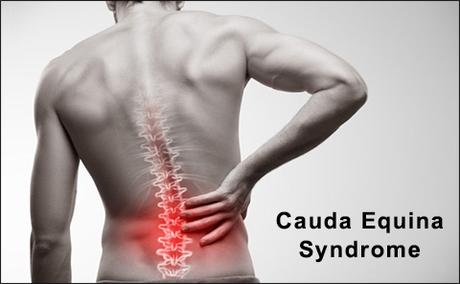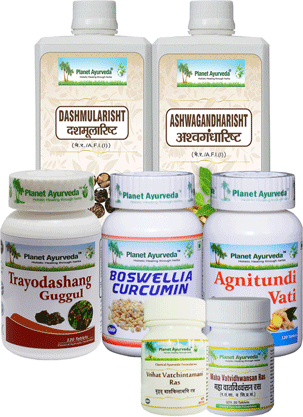ABSTRACT
Brain health is a growing and emerging concept which encloses neural development, functioning, plasticity and recovery over the life track. The nervous system is the body's command focus which originates from your brain and controls your thoughts, movements and automatically responds to the surrounding world. The daily living of a human being depends upon how they move around effectively accomplishing their day to day activities. You can't imagine the development of your lives without proper functioning of hands and legs. So what happens if somehow due to any health concern your legs are not working properly, your limbs become stiff or tight that restricts your day to day activities. Cauda Equina syndrome is one such disease about which we will discuss in this whole article along with its ayurvedic management.

INTRODUCTION
Cauda Equina Syndrome is a nervous disorder which occurs when there is dysfunction of sacral nerve roots and multiple lumbar. Cauda equina is a term that comes from the word horse's tail. Actually cauda equina refers to the sack of nerve roots at the lower end of the spinal cord. This is called a horse's tail as at the level of the cauda equina, the spinal cord does not remain as a tubular structure; here it appears like a horse's tail because of the collection of large nerves. Cauda equina syndrome is characterized by narrowing of vertebral canal that can result in the narrowing of nerve roots of the spine at the level of cauda equina. The main cause is compression of the nerves root at the level of cauda equina.
SOME FACTS ABOUT CAUDA EQUINA SYNDROME
Following are some facts about Cauda Equina Syndrome:
- It is relatively a rare condition
- This condition comprises 2-6% of all the lumbar disc problems
- The incidence of this particular disease is 1 in 33 thousand people to 1 in 100,000 people.
- In 5 years from 2003 to 2007 there is noticed 63 cases of Cauda Equina Syndrome.
CAUSES OF CAUDA EQUINA SYNDROME
Most cases of cauda equina syndrome occur as a result of Massive herniated disc in the region of lumbar vertebrae. As we studied earlier there is a pressure on the nerve roots at the level of cauda equina, following are certain factors that can cause pressure and leads to cauda equina syndrome:
- Spina bifida- congenital anomaly (in this spine and spinal cord not formed properly)
- Spinal lesions
- Lumbar spinal stenosis
- Spinal anesthesia
- Postoperative spine lumbar surgery
- Spinal hemorrhages
- Trauma leading fractures and dislocation
- Tumors or cyst at the site of cauda equina
- Infection
- Spinal arteriovenous malformation
SYMPTOMS OF CAUDA EQUINA SYNDROME
Following are the symptoms experienced by a person in Cauda Equina Syndrome:
- Inflammation of the nerve roots
- Saddle anesthesia (sensory disturbance)
- Tenderness over the area of cauda equina (pain while touching)
- Difficulty in rising up from sitting position
- Weakness in legs
- No pressure tolerance
- Urinary incontinence
- Fecal incontinence
- Sexual dysfunction
- Later on disc may rupture and person may become paralysed
DIAGNOSIS OF CAUDA EQUINA SYNDROME
Here are certain conditions that may resemble Cauda Equina Syndrome so it is must to diagnose this condition clearly. It will be done with proper diagnostic techniques that we are going to discuss below:
- Physical examination and patient history
- MRI (Magnetic resonance imaging)
- CT Scan
- Myelogram
AYURVEDIC VIEW OF CAUDA EQUINA SYNDROME
Cauda equina syndrome is a nervous disorder which leads to dysfunction of sacral nerve roots due to any degeneration or pressure at the site of Cauda equina. As per ayurveda it is correlated to avarana janya vatavyadhi that is the disease caused due to any obstruction in the normal flow which leads to vata dosha vitiation. Firstly there is an obstruction then it leads to vata dosha vitiation which further causes disorientation in normal functioning of the cauda equina. In this case we have to balance the vitiated vata dosha to relieve the various symptoms felt by the patient such as weakness in the legs, no pressure tolerance, bladder incontinence, fecal incontinence, etc. For this we are going to mention the Ayurvedic management by Planet Ayurveda so let's have a look.
HERBAL REMEDIES BY PLANET AYURVEDA FOR CAUDA EQUINA SYNDROME
Planet Ayurveda is a GMP certified clinic which has been working since many years under the rules of Ayurveda - A Holistic science. They formed their own herbal remedies under the strict observance of M.D. Ayurveda practitioners. All these remedies are devoid of any kind of added preservatives, colour, fibre, gums, resins and any kind of synthetic materials. As we read earlier for the management of Cauda Equina Syndrome there is a need to pacify vata dosha and to maintain the functions of cauda equina. For this purpose Planet Ayurveda provides you with 7 remedies that we are going to discuss below:
- Vrihat Vatchintamani Ras
- Trayodashang Guggul
- Ashwagandharisht
- Boswellia Curcumin
- Maha Vatvidhwansan Ras
- Dashmularishta
- Agnitundi Vati


PRODUCTS DESCRIPTION
1. VRIHAT VATCHINTAMANI RAS
Vrihat vatchintamani ras is one of the best classical ayurvedic formulations which is used for various vataj vyadhi since ancient times. This remedy is formulated by Planet Ayurveda under the strict observance of M.D. Ayurveda practitioners and available in tablet form. These tablets consist of ingredients such as swarna bhasma (calyx of gold), abhrak bhasma (calyx of mica), rajata bhasma (calyx of silver) and various others. As in this condition there is an obstruction in the path of cauda equina which leads to vata dosha vitiation and causes difficulty in the normal functioning of Cauda Equina. Vrihat Vatchintamani Ras by pacifying vata dosha helps in regulating the functions of Cauda Equina.
Dosage: 1 tablet twice daily to be chewed.
2. TRAYODASHANG GUGGUL
Trayodashang guggul is a remedy in tablet form and prepared by Planet Ayurveda as mentioned in the classical texts. This remedy is one of the best remedies for degenerative neurological conditions. This is a guggul preparation which means the ingredients are processed with guggul (Commiphora mukul), ashwagandha (Withania somnifera), giloy (Tinospora cordifolia), shatavari (Asparagus racemosus), gokhru (Tribulus terrestris) and various others. This tablet formulation has been used in various degenerative conditions since ancient times. So by pacifying, restricting the further degeneration and reducing the inflammation and tenderness at the level of the lumbar region these tablets prevent compression on cauda equina and assists the management.
Dosage: 2 tablets twice daily with plain water after meals.
3. ASHWAGANDHARISHT
This is one of the formulations available in syrup form which is prepared by Planet Ayurveda under the strict observance of M.D. Ayurveda practitioners. Ashwagandhaarisht is one of the best nervine tonic as it consists of ingredients such as ashwagandha (Withania somnifera), safed musli ( chlorophytum tuberosum), arjuna ( Terminalia arjuna), mulethi ( Glycyrrhiza glabra) and various others. This formulation is regarded as one of the rasayana that prevents the degenerative changes and also this syrup helps in alleviating the weakness in the muscles. So this syrup can be administered in managing the symptoms of the Cauda Equina Syndrome.
Dosage: 2 tsp twice daily with added equal amount of plain water.
4. BOSWELLIA CURCUMIN
Boswellia Curcumin is a herbal remedy formulated by Planet Ayurveda in capsule form. These capsules consist of standardised extract of shallaki (Boswellia serrata) and curcumin (Curcuma longa). As we studied earlier in causes and symptoms of Cauda Equina Syndrome which includes the most common cause a degenerative change or obstruction at the level of cauda equina which leads to the symptom such as inflammation of the nerve roots and tenderness over the area of nerve roots. So having antiinflammatory and antioxidant properties these capsules helps in alleviating the condition of cauda equina syndrome.
Dosage: 1 capsule twice daily with plain water after meals.
5. MAHA VATVIDHWANSAN RAS
Maha vatvidhwansan Ras is one of classical ayurvedic formulations which has been used since ancient times in various bony degenerations. Cauda equina syndrome caused by any pressure hindrance due to bone deformity at the level of the lumbar region. So by providing strength to the bony parts at the level of cauda equina these tablets help in preventing the further degeneration and prevent the symptoms of cauda equina syndrome.
Dosage: 1 tablet twice daily to be chewed.
6. DASHMULARISHTA
Dashmularishta is one of the best vata anulomana syrups mentioned in classical texts. This preparation is formulated by Planet Ayurveda under the strict observance of M.D. Ayurveda practitioners. It includes various ingredients such as bilva ( Aegle marmelos), gambhari (Gmelina arborea), patola (Stereospermum suaveolens) and various others. Dashmularishta is basically a very best vata anulomaka remedy which by regulating the vata dosha maintains its proper functioning. As vata dosha is directly correlated to our nervous system so it aids in regulating the functioning of nerves also. That's why this herbal syrup is considered as best for managing the symptoms of Cauda Equina Syndrome.
Dosage: 2 tsp twice daily with added equal amount of plain water.
7. AGNITUNDI VATI
Agnitundi vati is a herbal remedy in tablet form, formulated by Planet Ayurveda as per strict observance to classical ayurvedic texts. These tablets consist of ingredients such as ginger ( Zingiber officinale), marich ( Piper nigrum), pippali (Piper longum) and various others. This herbal remedy is very effective for ama pachana that is the basic need of every line of treatment in case of avarana. By alleviating ama dosha from the body, agnitundi vati makes the management effective.
Dosage: 1 tablet twice daily with plain water after meals.
CONCLUSION
Cauda Equina Syndrome is a nervous disorder which occurs when there is dysfunction of sacral nerve roots and multiple lumbar. Cauda equina syndrome is characterised by narrowing of vertebral canal that can result in the narrowing of nerve roots of the spine at the level of cauda equina. Most cases of cauda equina syndrome occur as a result of Massive herniated disc in the region of lumbar vertebrae, rather than this any pathology which leads to compression on cauda equina is the reason behind Cauda Equina Syndrome. Various symptoms of this condition includes faecal and urine incontinence, weakness in legs, sexual dysfucntion and later on leads to paralysis. As per ayurveda it is correlated to avarana janya vata vyadhi and this condition is managed by removing the avarana and then pacifying the vata dosha. For this purpose Planet Ayurveda also provides you diet plan to prevent paralysis. These remedies are totally free from any kind of added preservatives and synthetic materials so feel free to consume these remedies and if you face any query while using these medications you can share it on www.PlanetAyurveda.com

